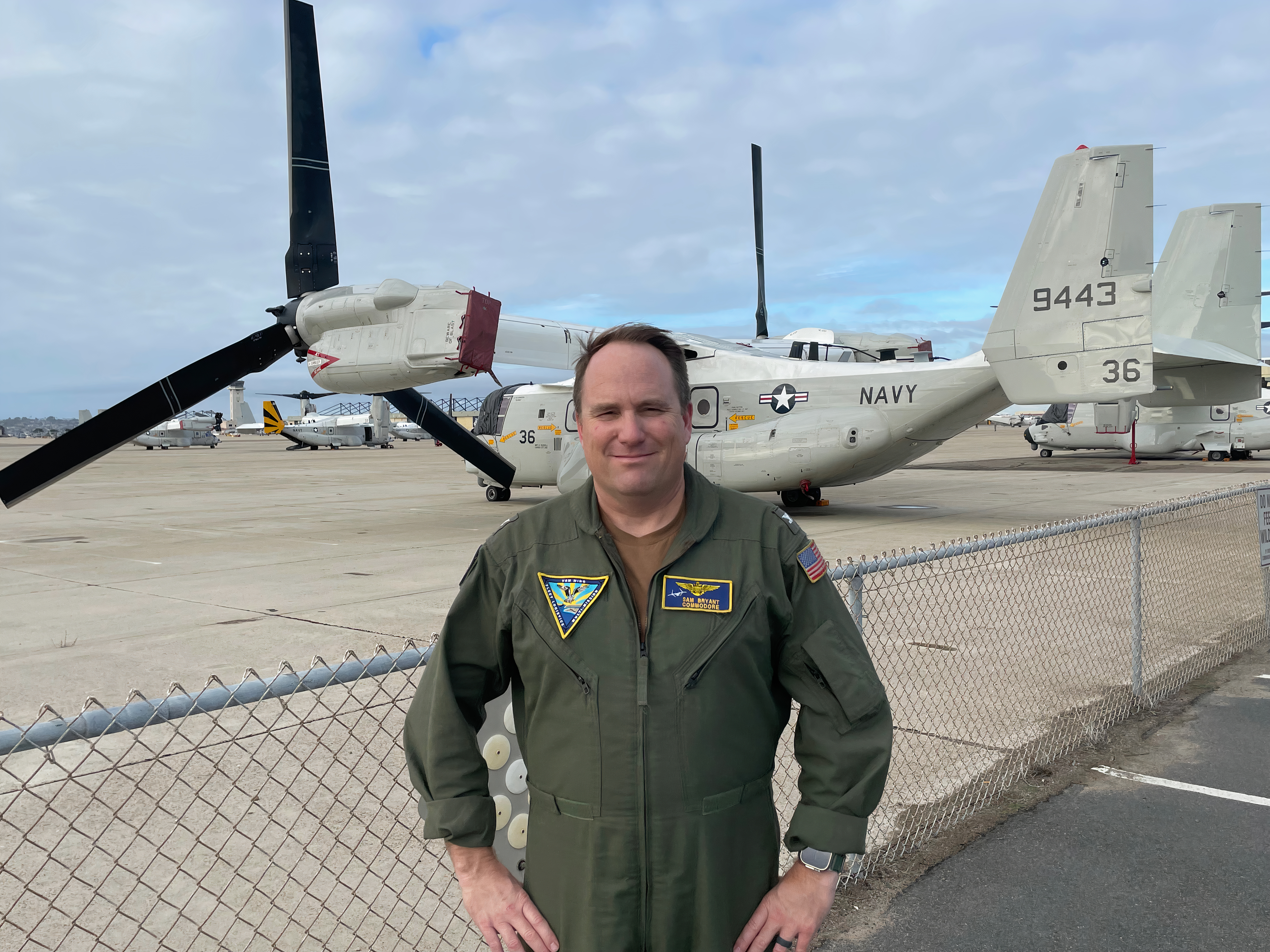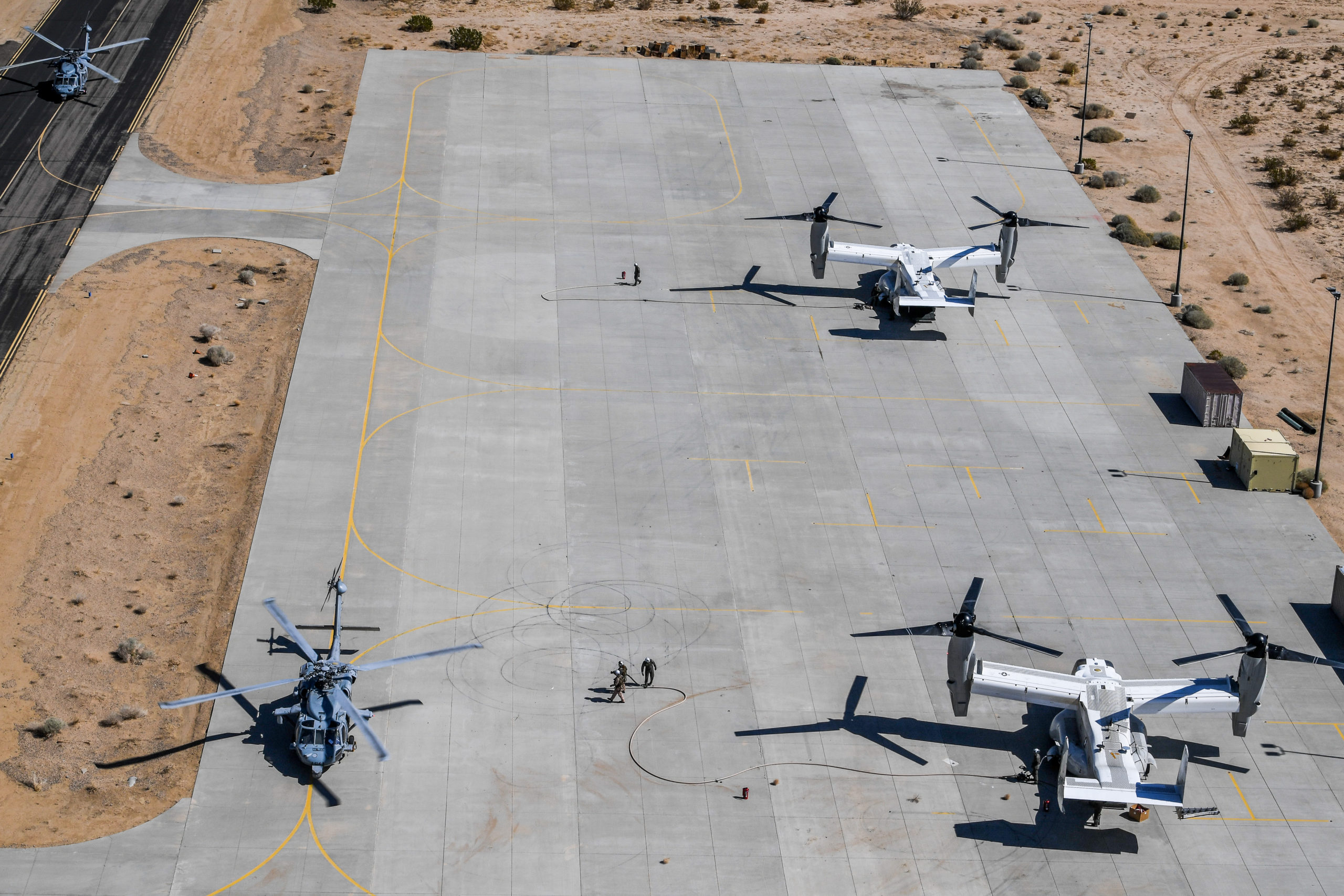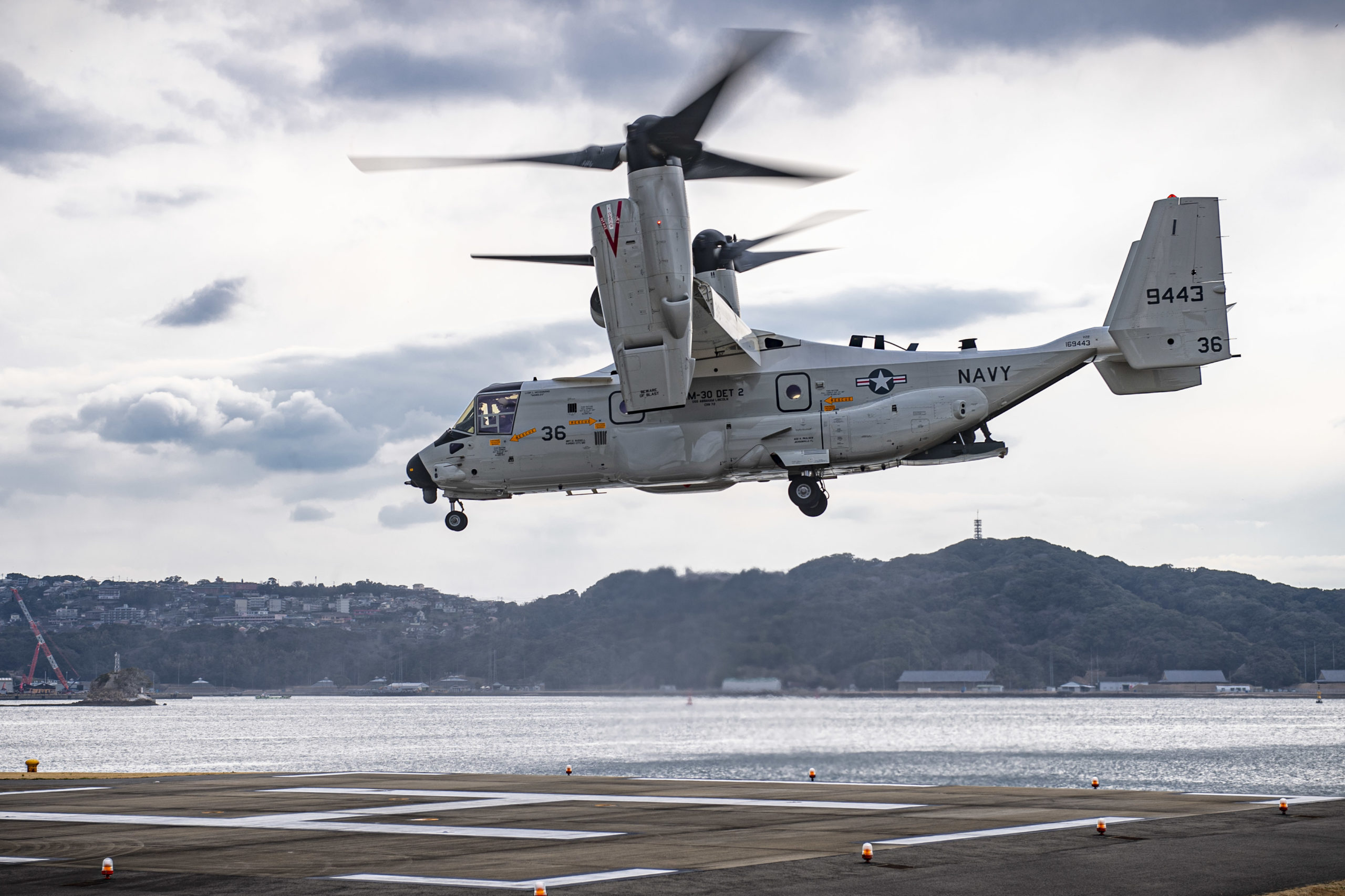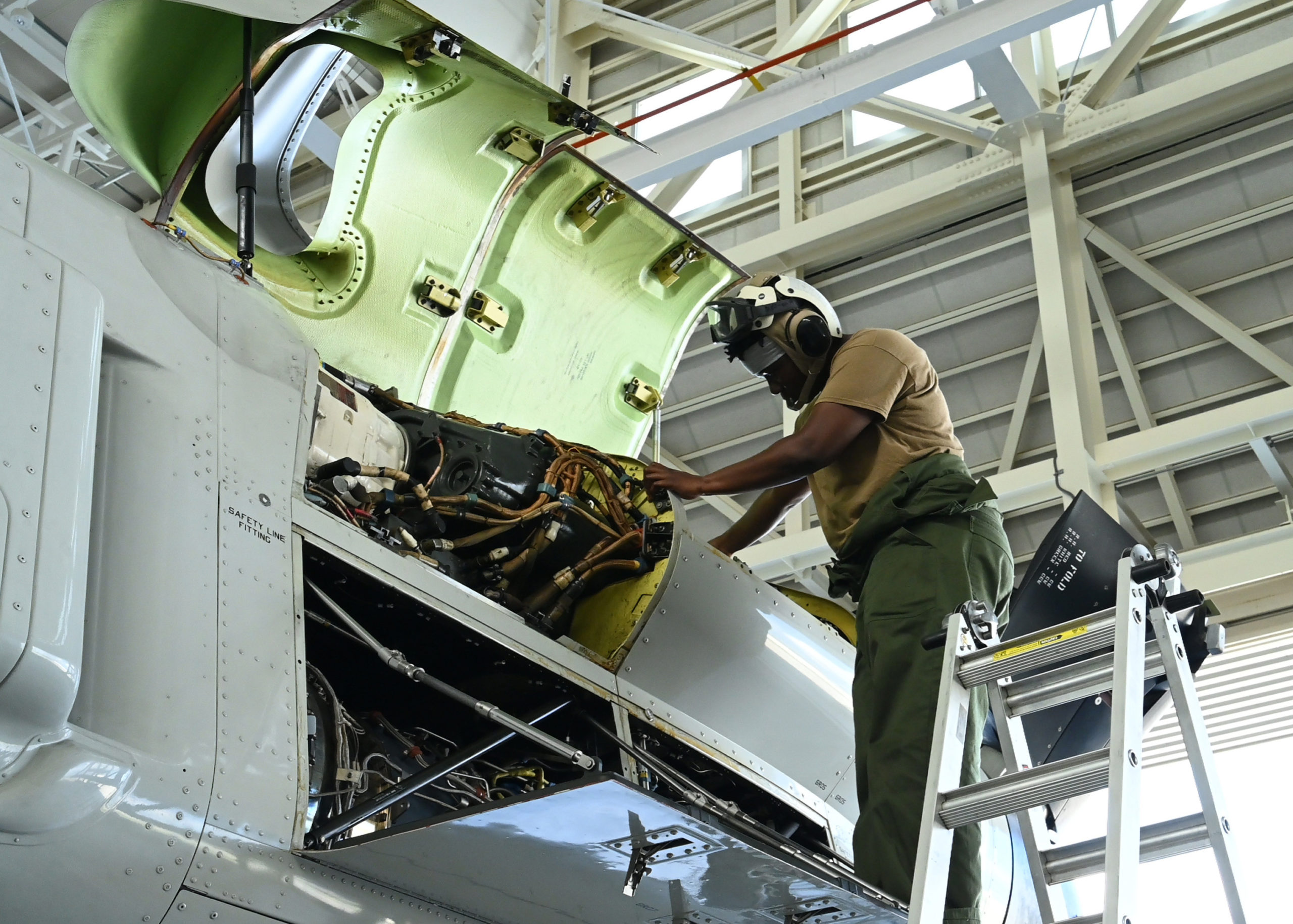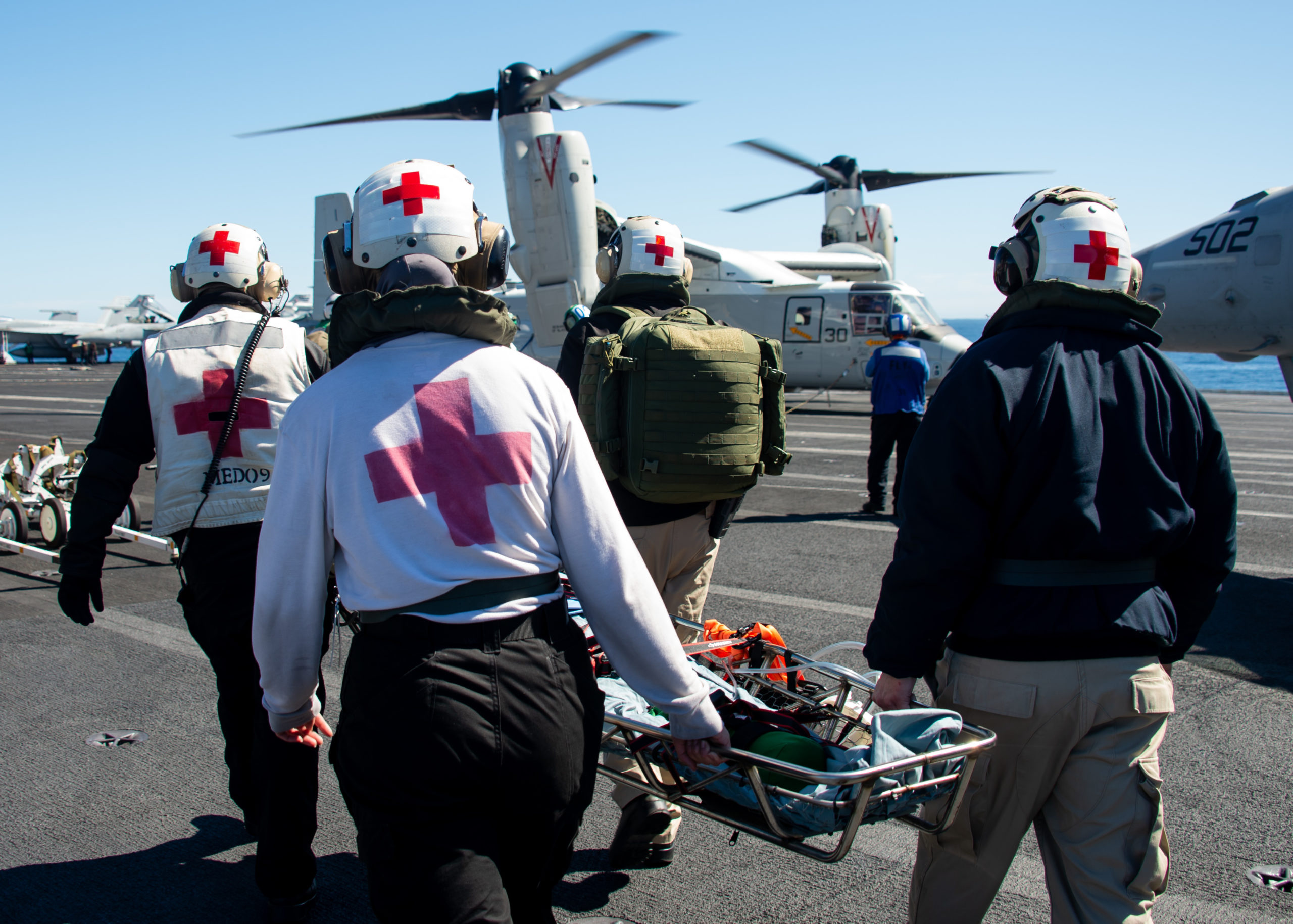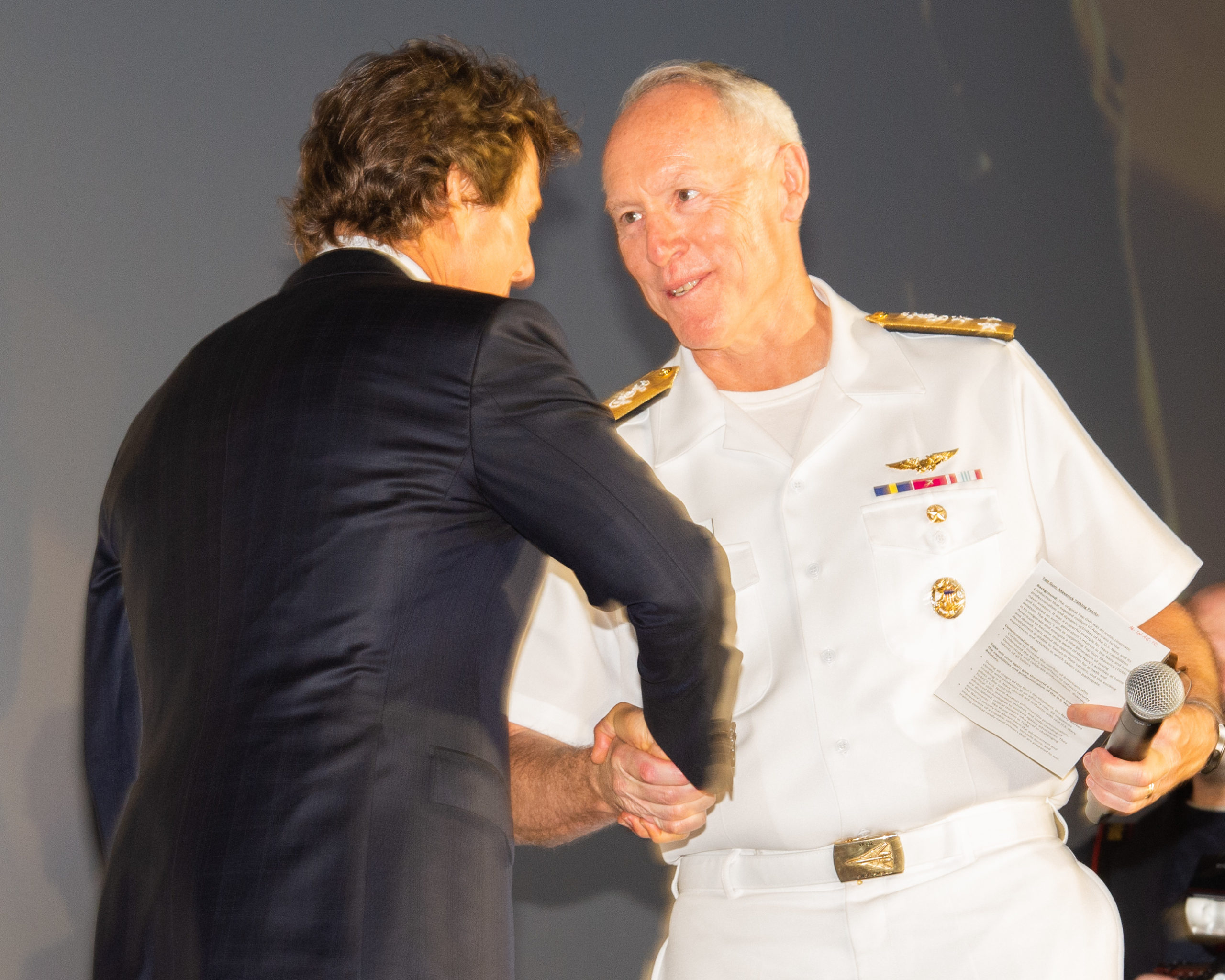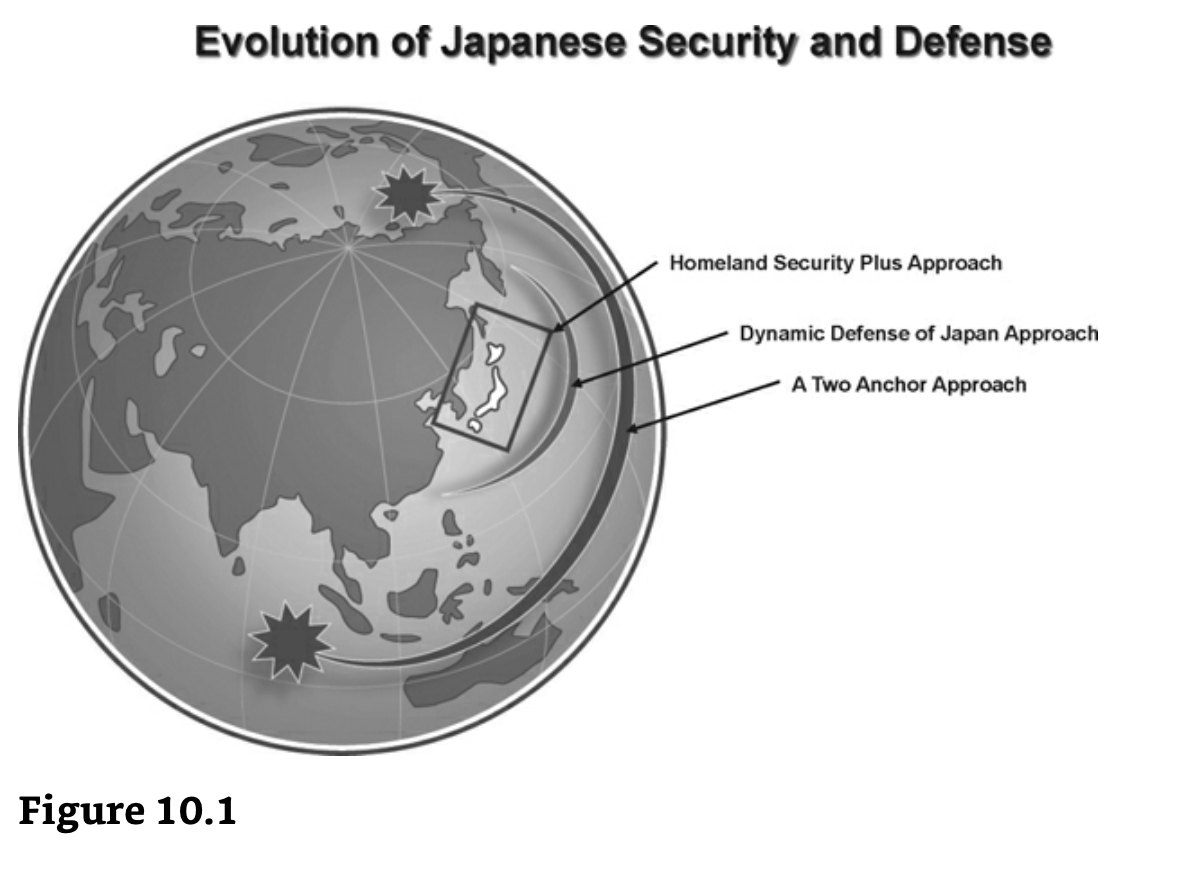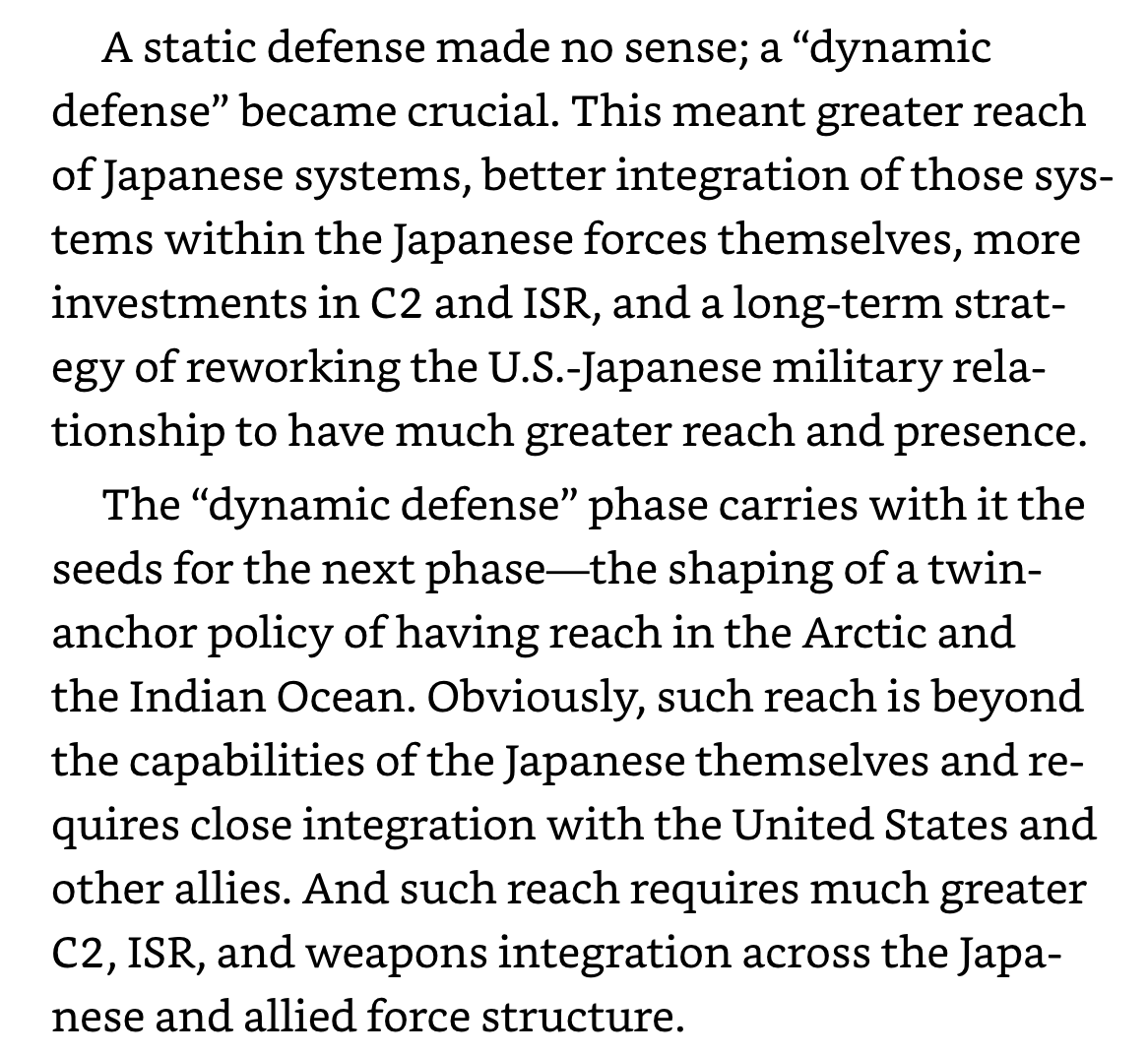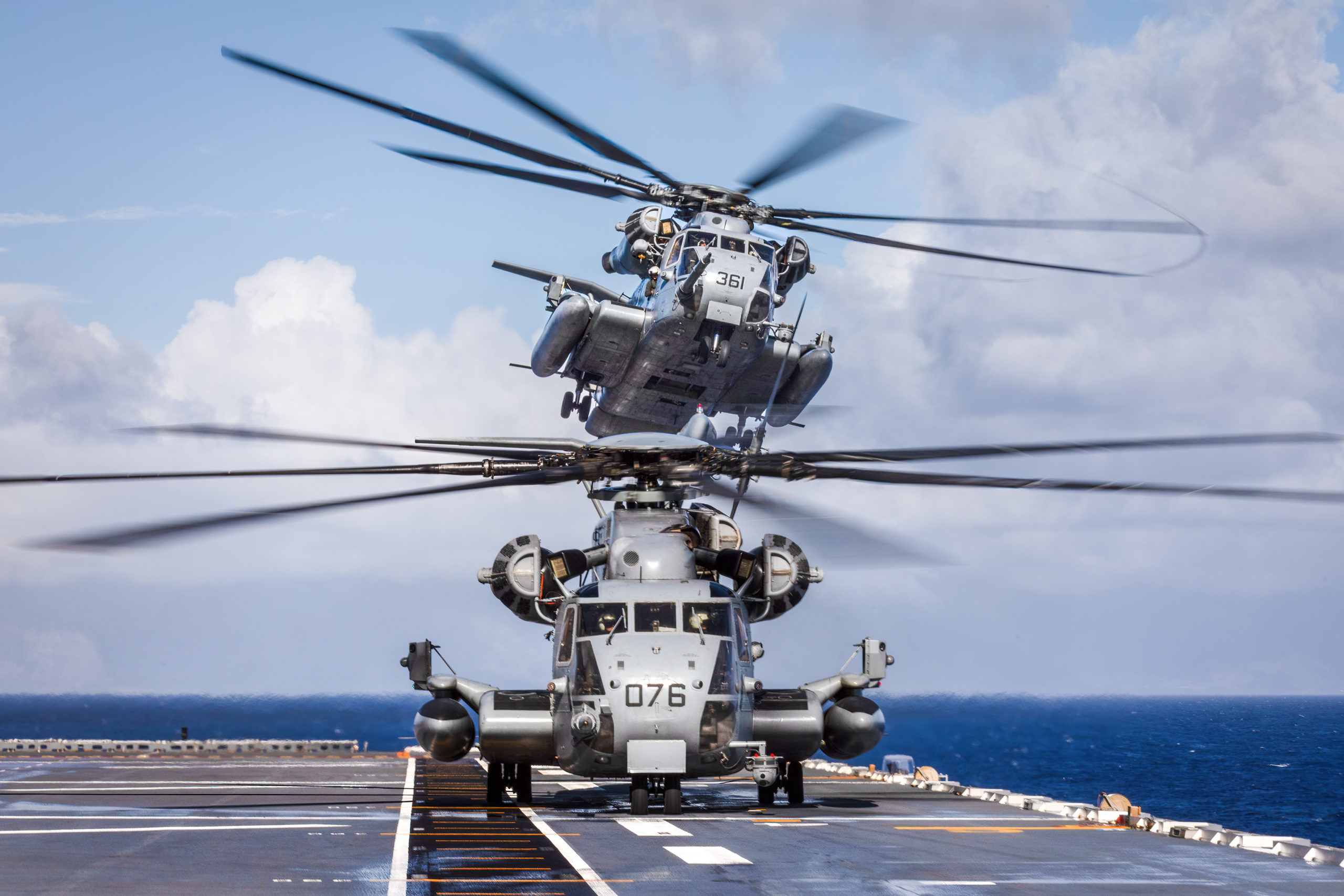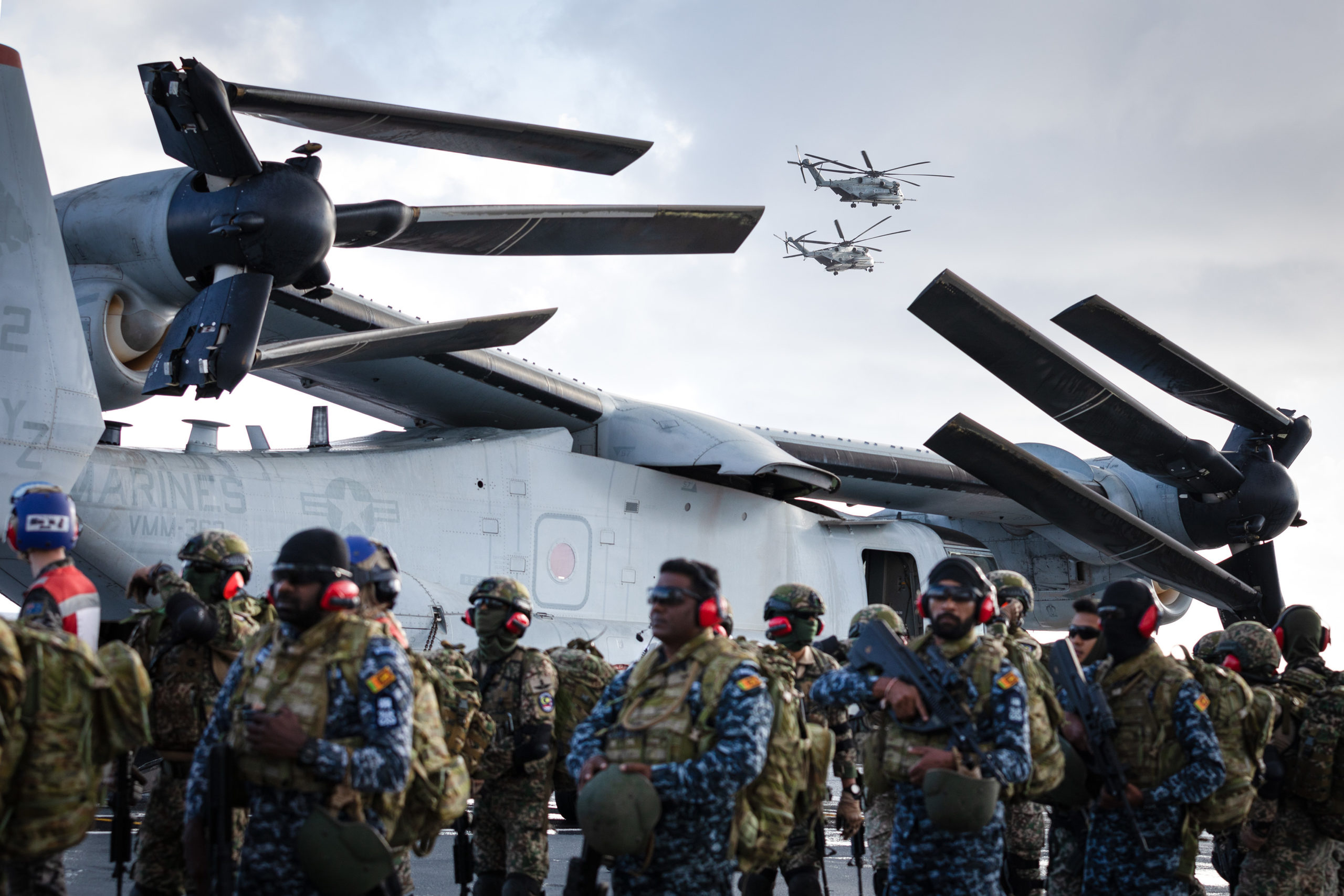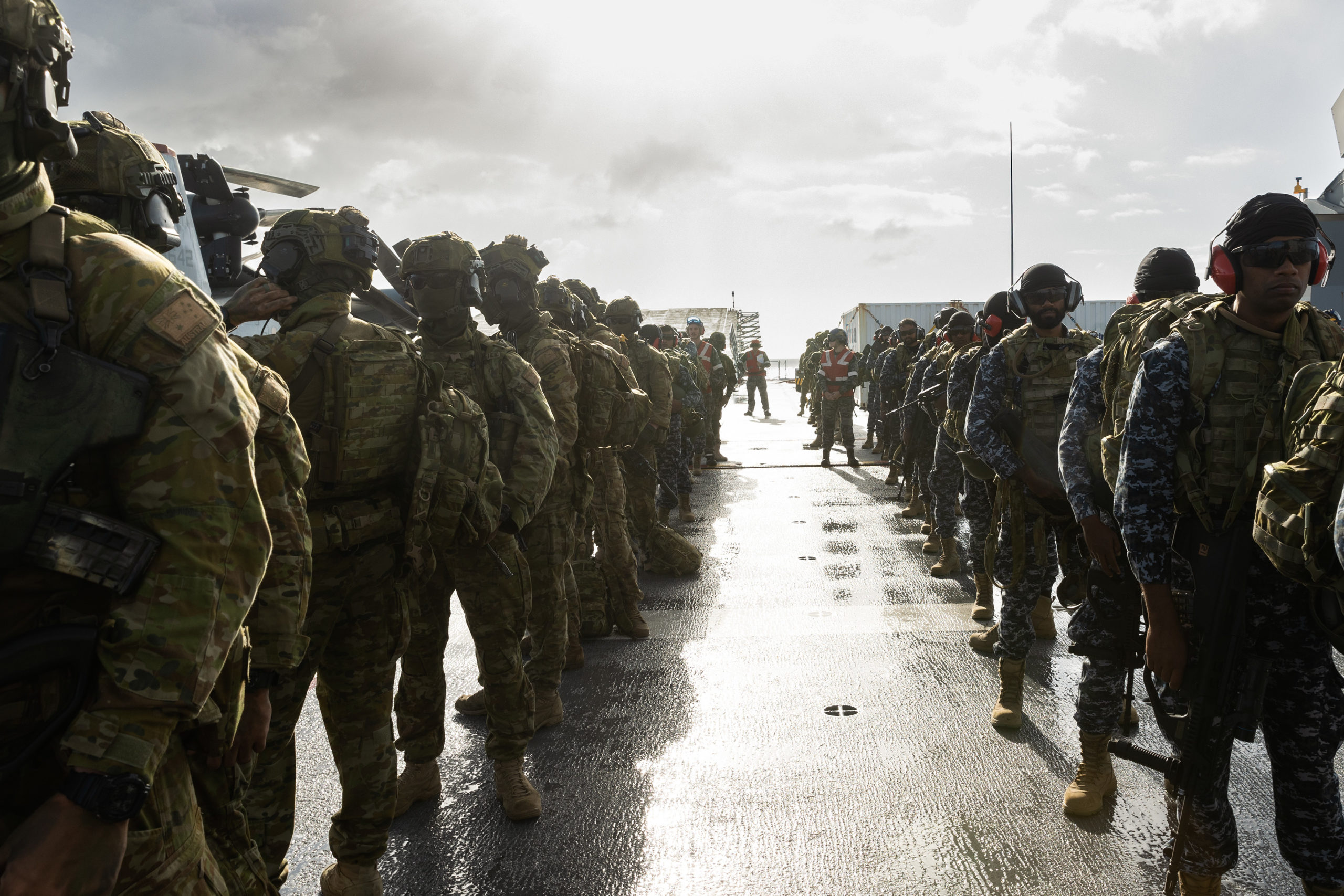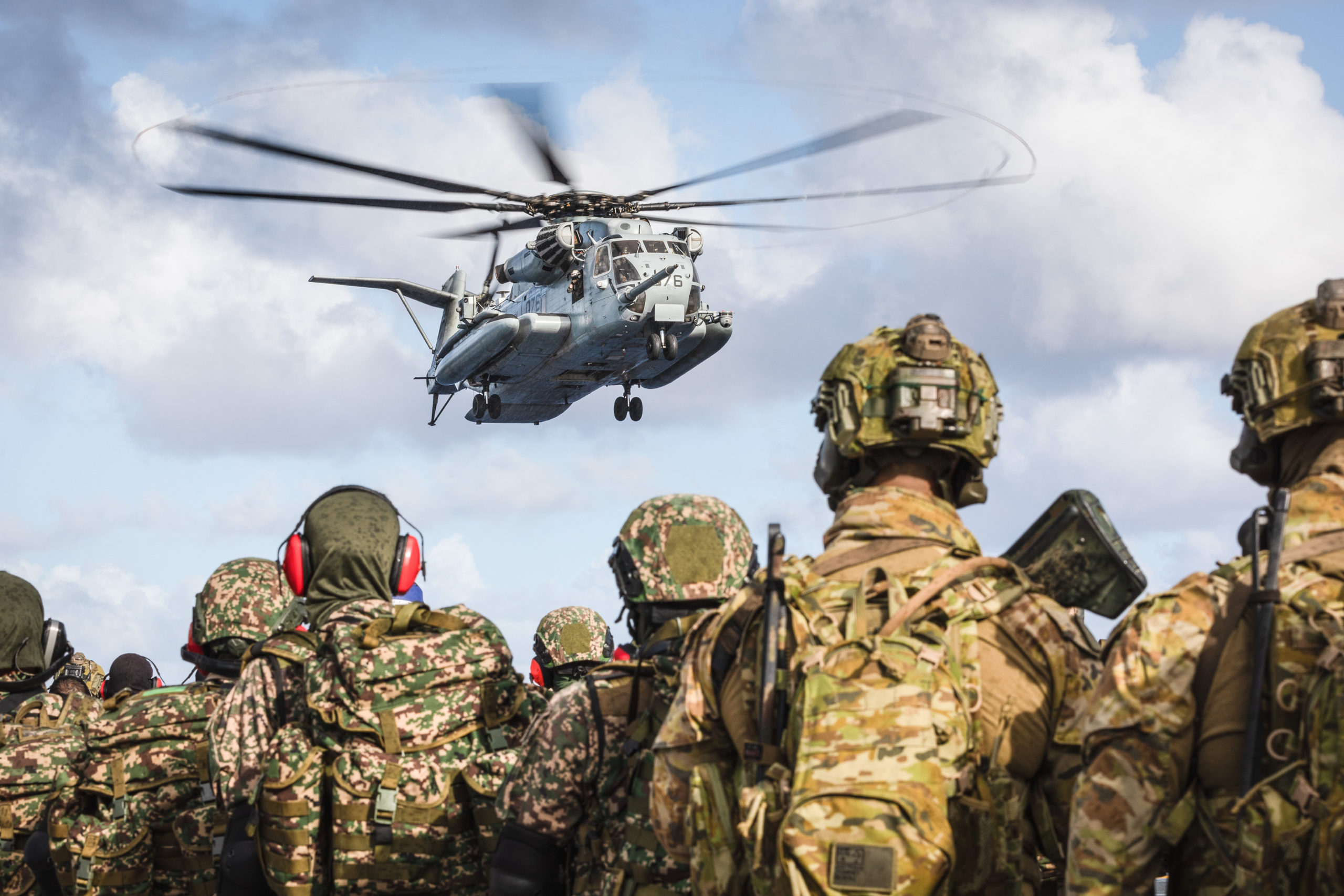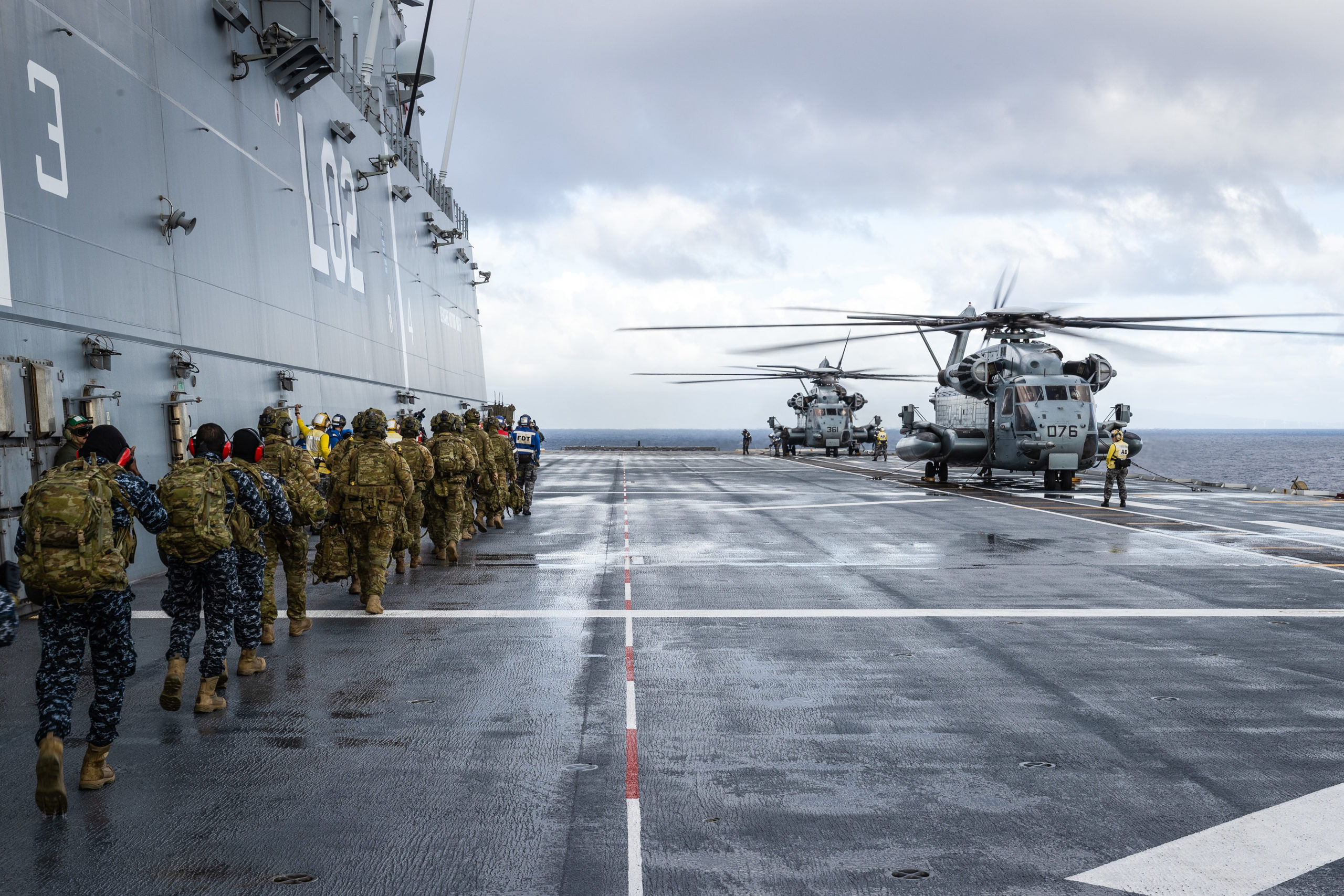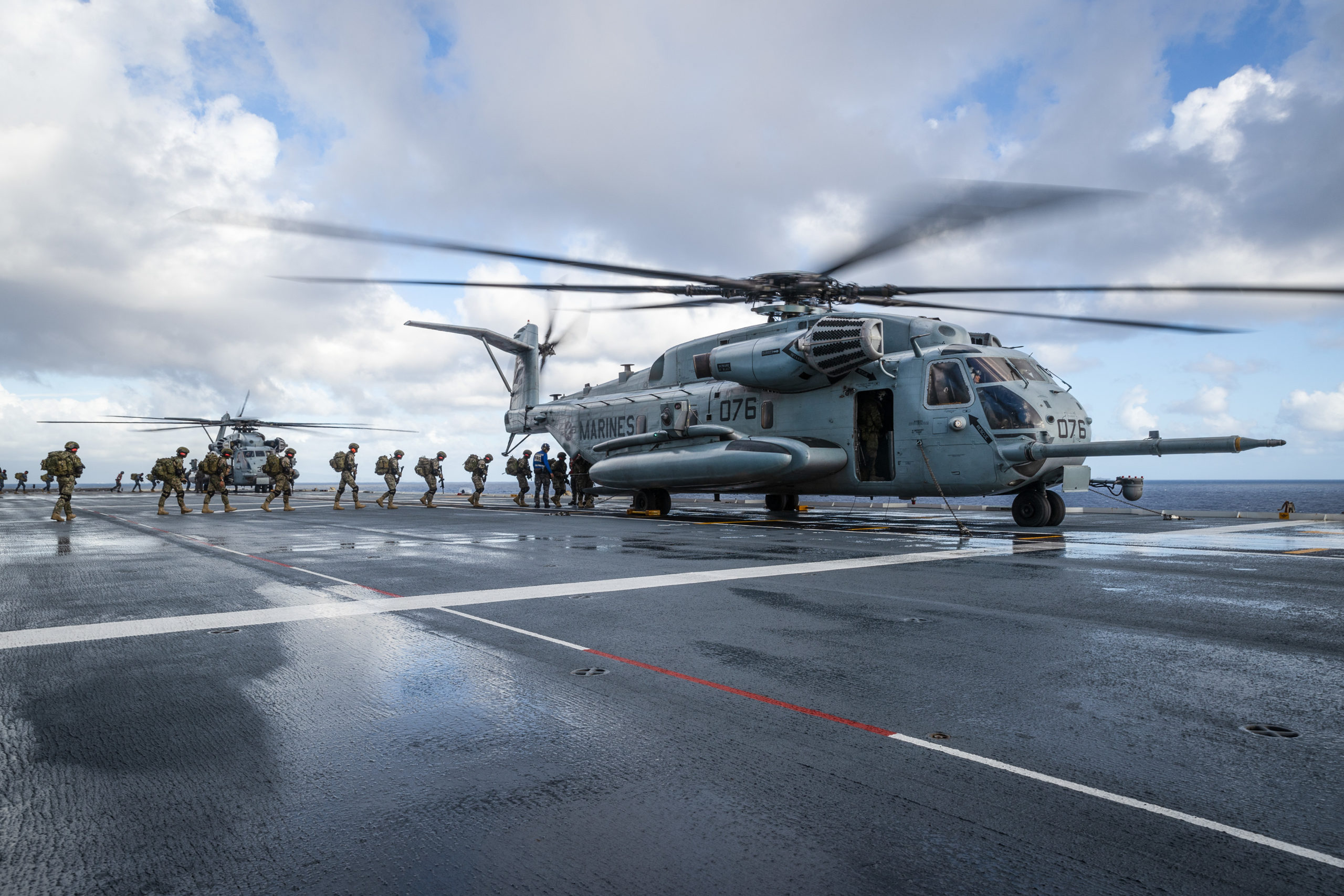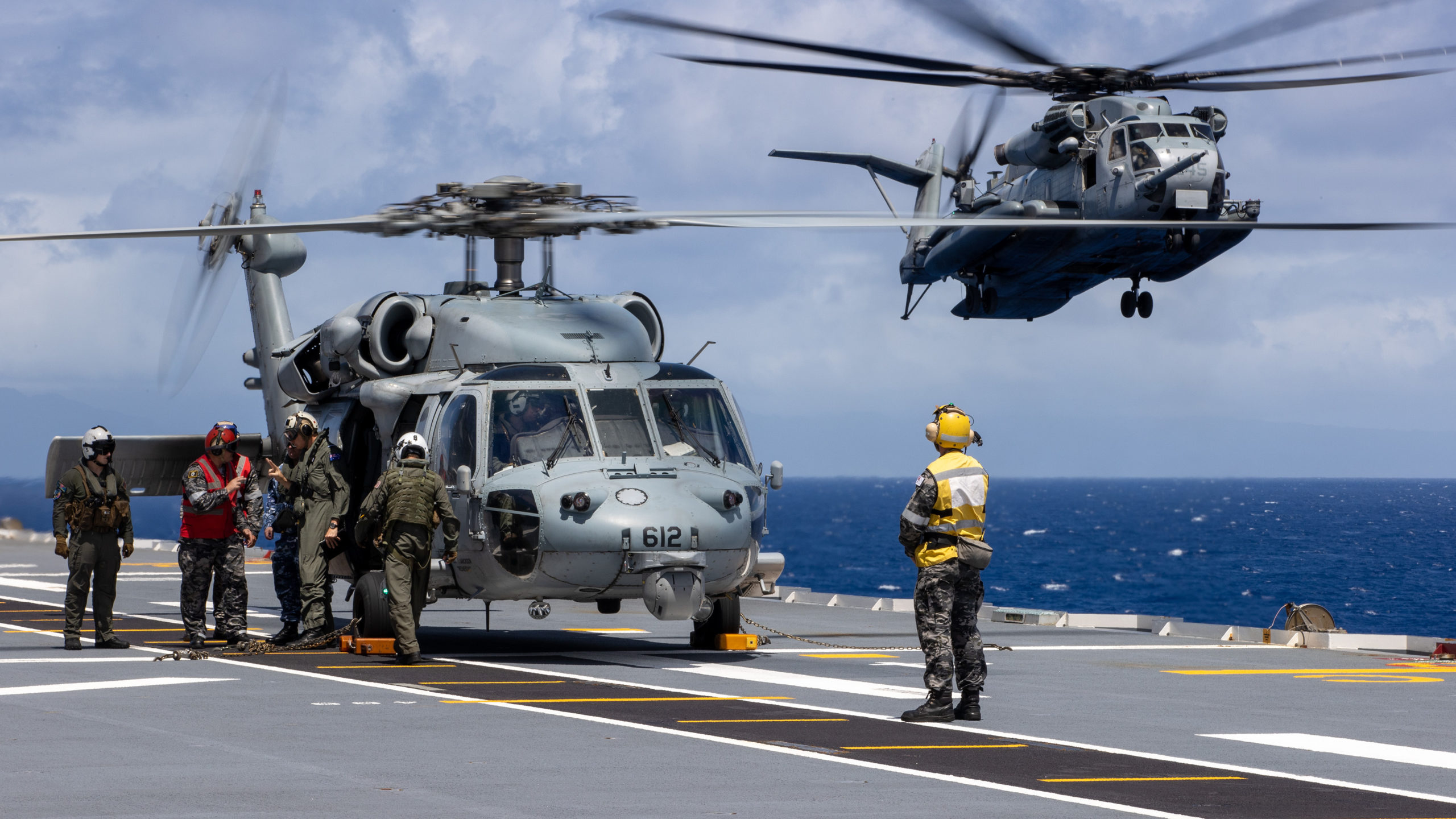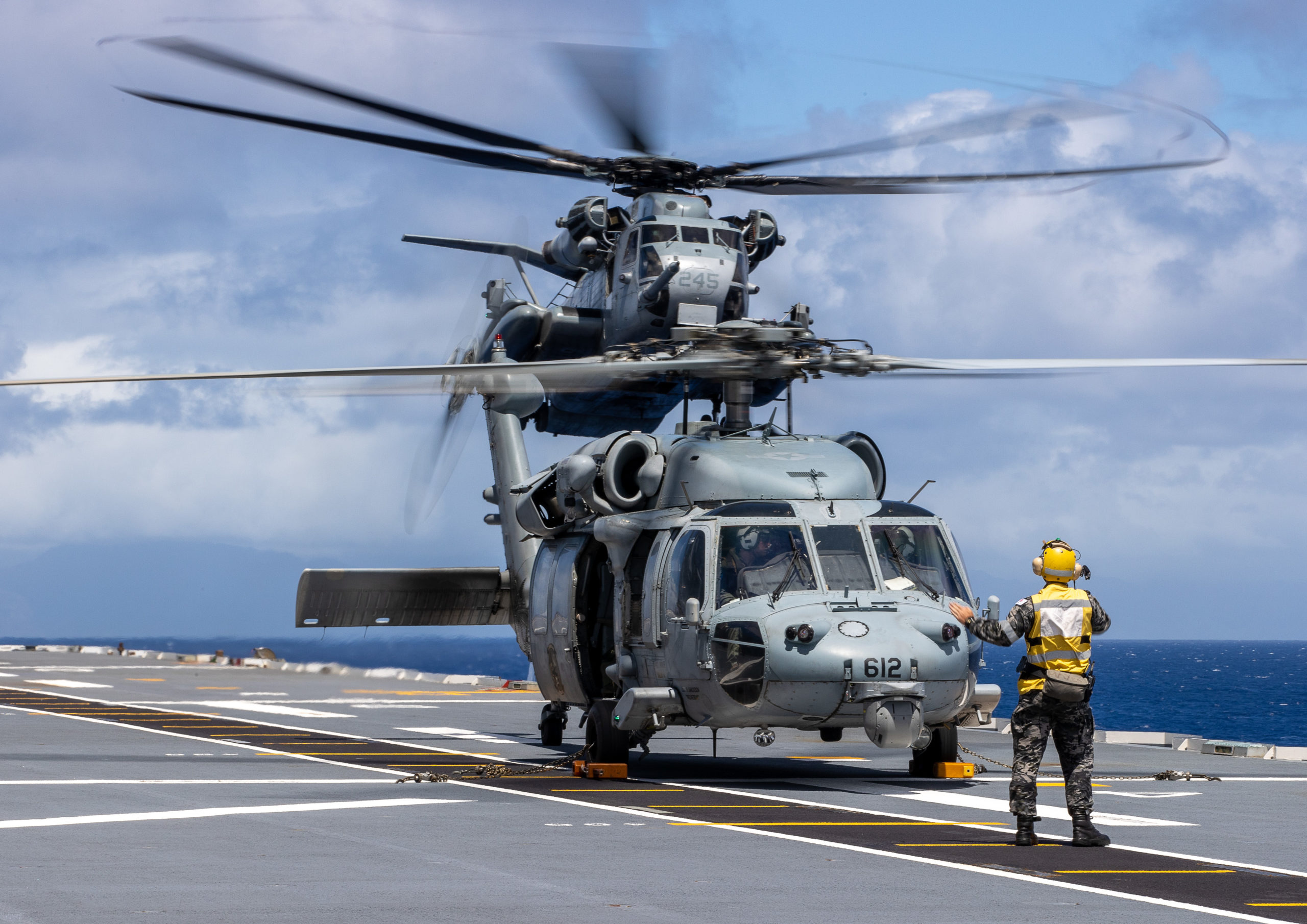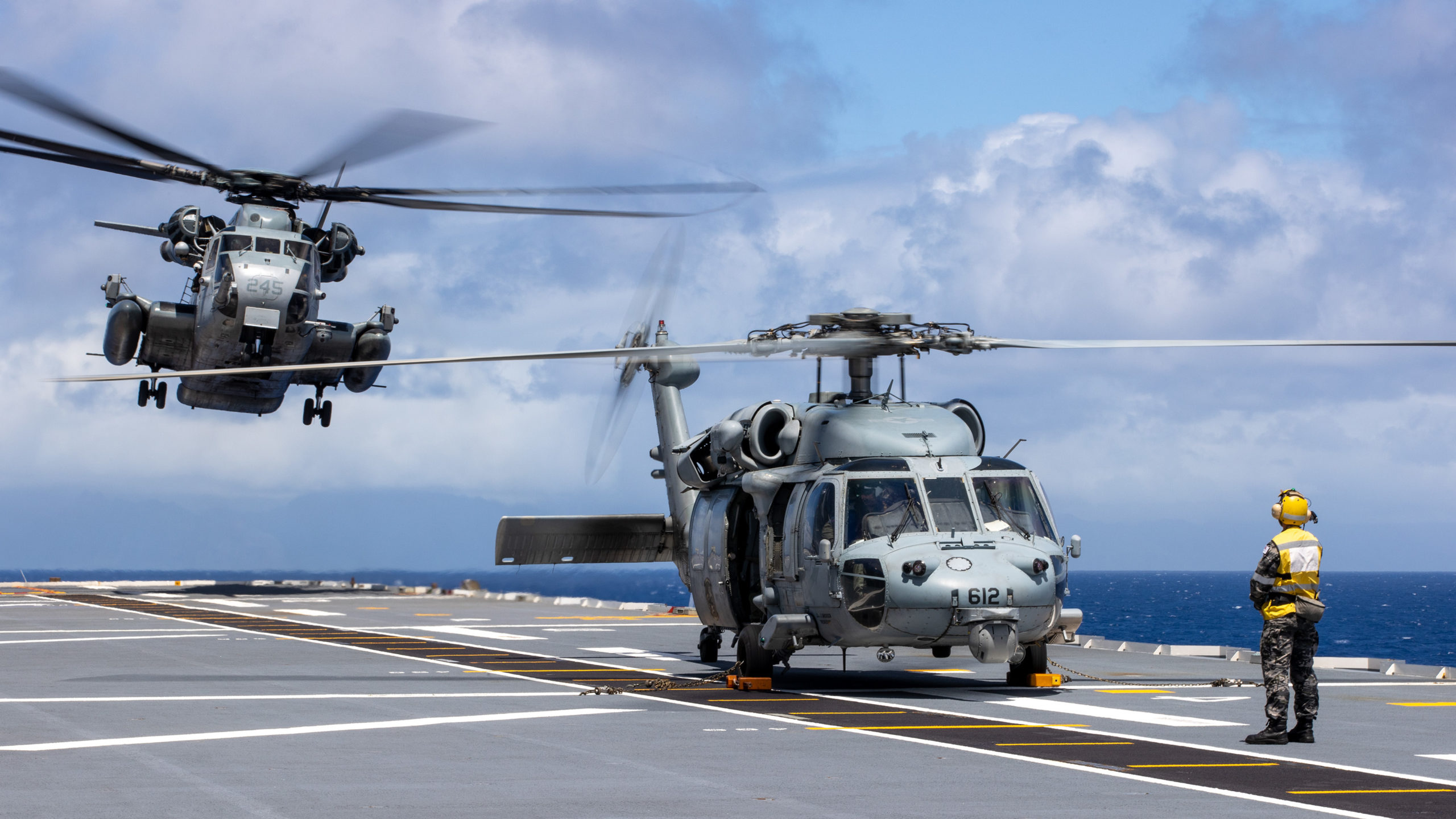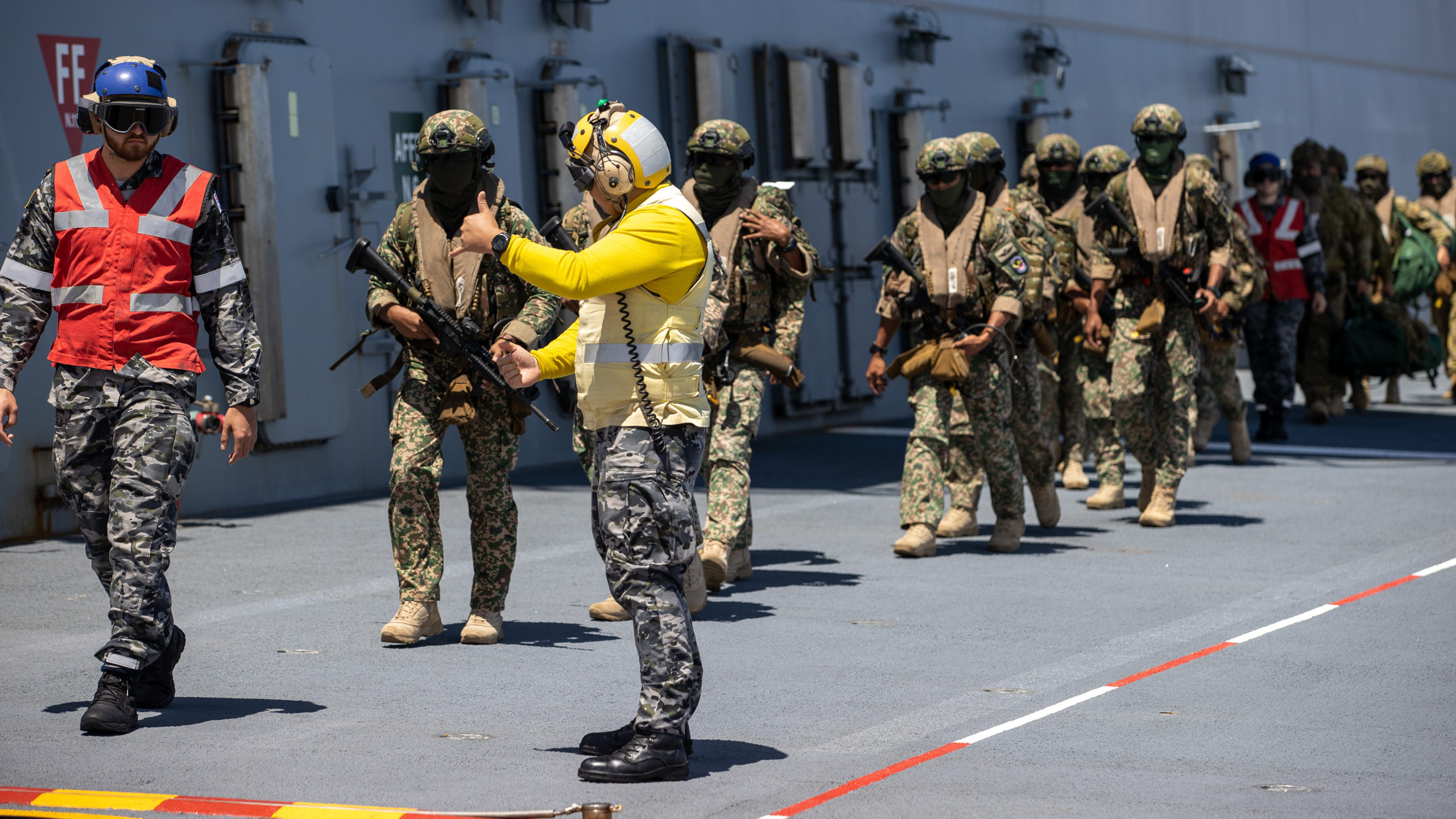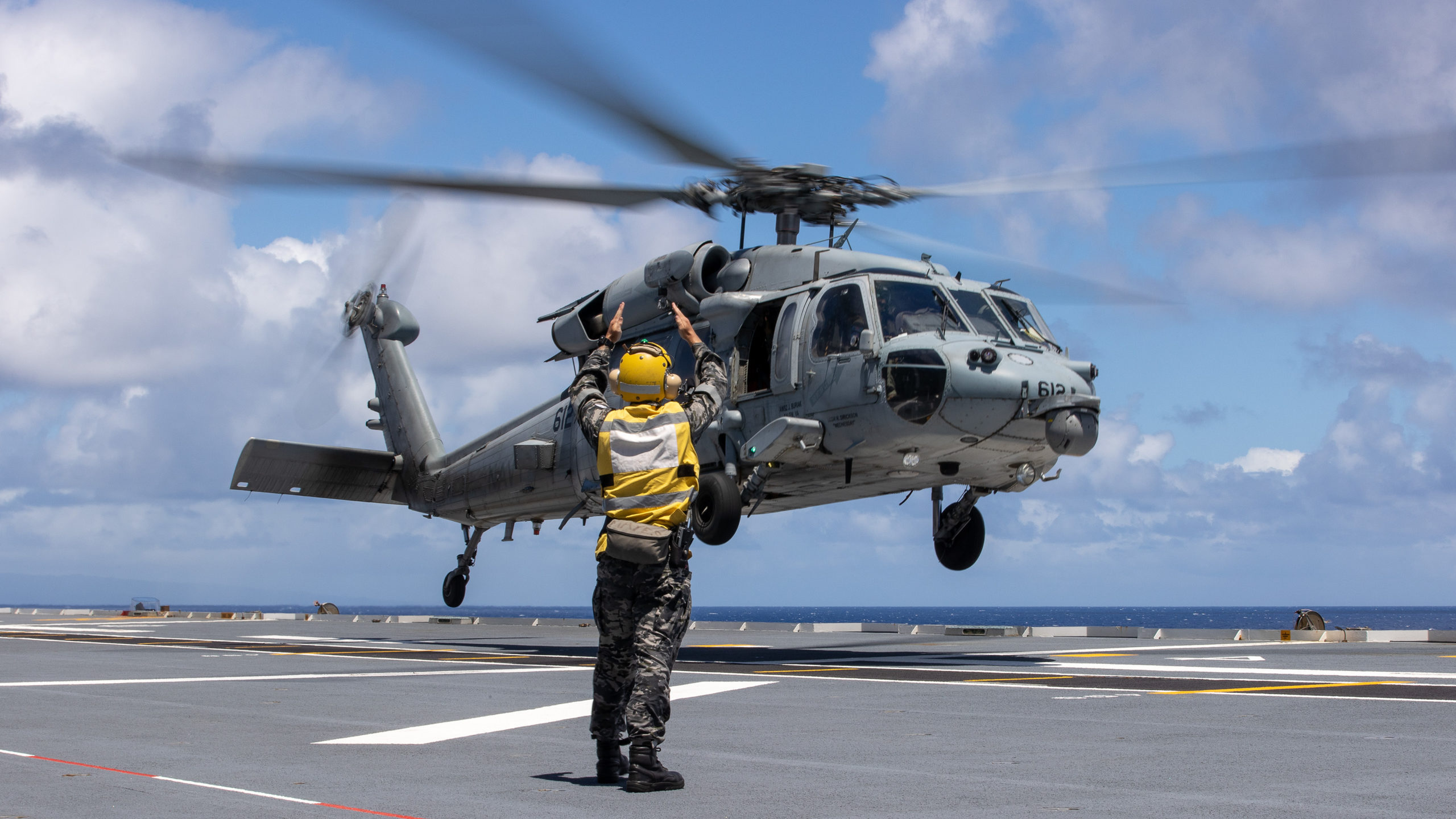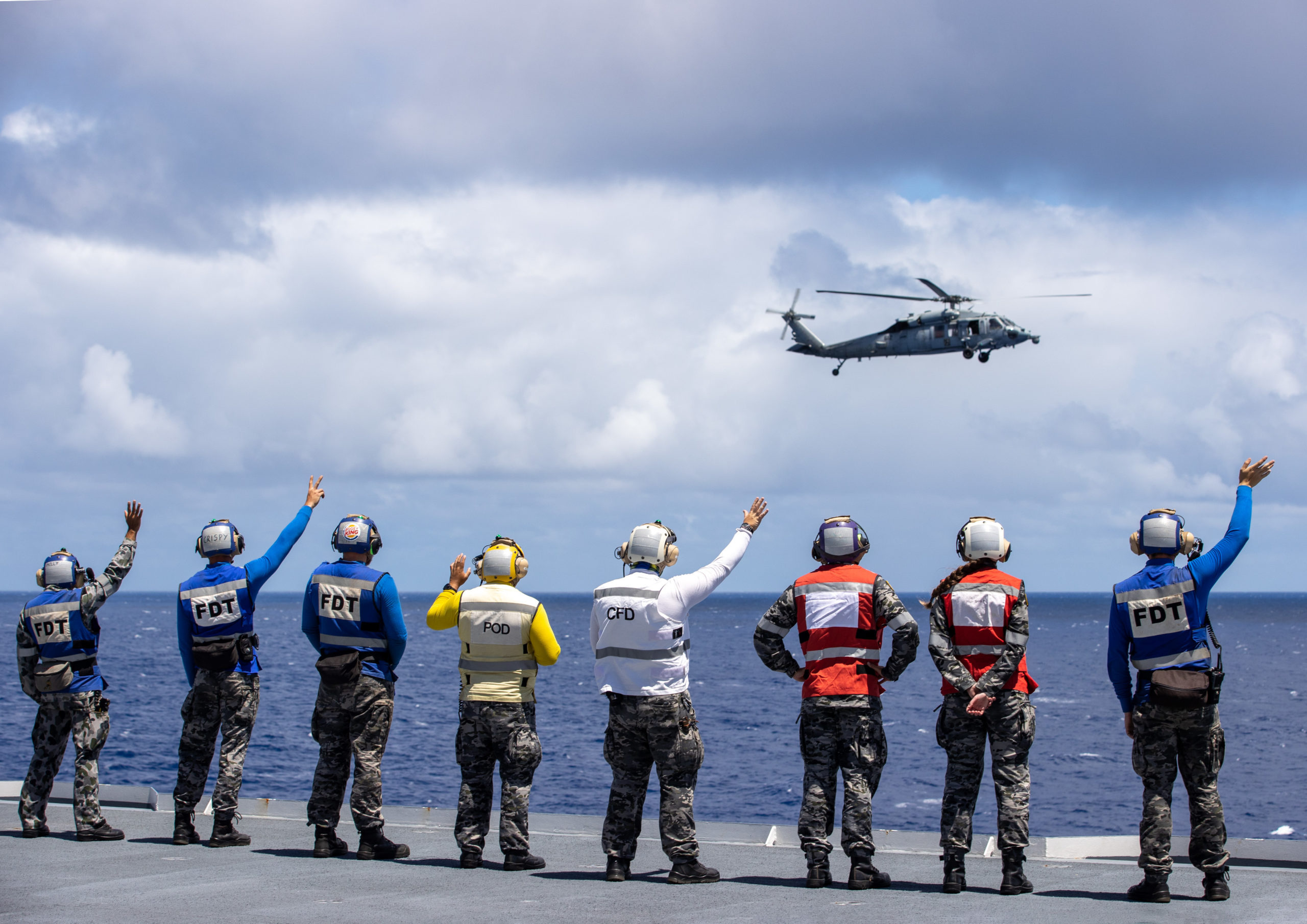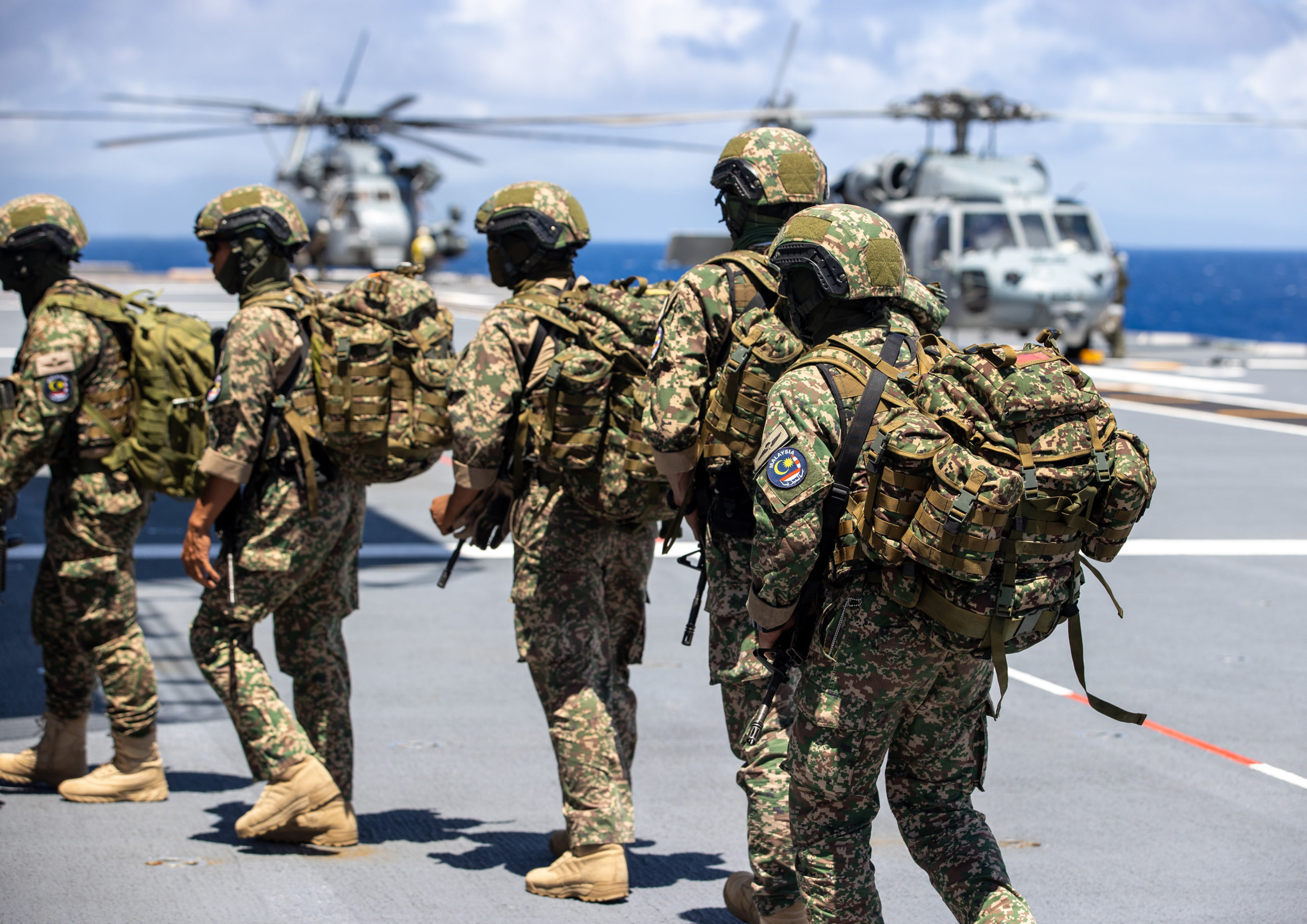By Robbin Laird
The CMV-22B has been bought by the U.S. Navy as a replacement for the C-2A Greyhound aircraft to provide for the carrier on-board delivery mission for the large deck carrier fleet. The numbers of the aircraft ordered for this mission are 48 and are sized to provide for the mission projected for peacetime conditions and derived from the Defense Strategic Guidance 2012.
Currently, the CMV-22B is being used following the same concepts of operations which the C-2A Greyhound executed.
The C-2A is a fixed wing aircraft operating from runways and landing on a carrier in point-to-point operations. But the CMV-22B is an Osprey: it does not need runways to take-off from is not constrained to runway enabled point-to-point operations.
This reminds me of the impact of the Osprey on the USMC and its at sea operations. The legacy ARG-MEU operated within a 200-mile geographical box due to the range and speed of the helicopters operating from the amphibious ships. With the Osprey’s speed and range, the ARG-MEU over time became the amphibious task force. Something similar is very possible for the Navy as the fleet commanders consider a shift from thinking of the CMV-22B as a C-2A replacement and recognize it as a fleet asset.
Such a shift was suggested during my visit to the CMV-22B “reveal ceremony” in Amarillo, Texas held on February 6, 2020. There I met CAPT (ret.) Sean McDermott who currently is a commercial airline pilot who served in the US Navy for 26 years. He was involved with the C-2 during the majority of his career, starting as a Greyhound pilot and eventually commanding one of the Navy’s two fleet logistics squadrons. In the final years of his service, McDermott was involved in working through options for the Navy as they considered C-2 replacements, with an eventual Osprey selection.
This is what McDermott projected: “With the C-2 we did one thing – Carrier On-board Delivery. With the Osprey, Combatant Commanders already know the multi-mission capability of the V-22 and will be tempted to utilize them for a variety of other missions. This is not something that would happen with a C-2. Carrier leadership will eventually struggle to fence off their logistics assets from outside tasking.”
In other words, there is an anticipated operational demand that fleet commanders will want to leverage fully the new versatile capabilities of the Osprey. McDermott noted that with the new platform being introduced to carrier aviation, it will be possible to leverage it to shape a greater range of capabilities for the COD asset. He noted that as the Marines began to get comfortable with the MV-22, they shaped the unique Special Purpose Marine Air-Ground Task Force (SP-MAGTF), which has become a highly demanded asset. He argued that such innovation was certainly possible for the Navy as it worked with its new COD aircraft.
Now the CMV-22B has come to the aircraft carrier.
The first two deployments have been to the USS CARL VINSON (CVN-70) and to the USS ABRAHAM LINCOLN (CVN-72). Clearly, with initial deployments the key focus is upon ensuring that the basic COD mission is executed and the CMV-22B is integrated into carrier deck operations. Any thought beyond that needs to be secondary to ensuring that the core mission is executed.
But when assured of that, leveraging the capabilities of the Osprey needs to be considered especially in light of the Navy itself changing the con-ops of the fleet and the role of the carrier in terms of those changing con-ops.
In my co-authored book with Ed Timperlake on the Navy and changing con-ops, we had one chapter which precisely addressed re-imaging the role of the large deck carrier. We noted in that chapter:
“A good sense of how the large-deck carrier and its operations are being reworked and reimagined was discussed with a senior U.S. Navy officer we talked to in 2020 about the way ahead for the large-deck carrier. That officer underscored that “The carrier strike group battlespace has gone from being where the engagements occur to a situation in which the carrier strike group itself becomes a piece on the larger chessboard, which will, from a Navy perspective, be managed at the numbered fleet level. Because of the sensor and communications technologies and the weapons evolution, the chessboard is bigger, and the large deck carrier is feeding into the interactive kill webs through which we operate on that chessboard. The numbered fleet becomes the command-and-control node, which is why we are seeing the numbered fleets standing up in maritime operations centers that we did not have before. The size of the chessboard is enlarging significantly, with kill webs, that can stretch for thousands of miles, when you add in things like Triton or satellites.”
“The officer then added that “The Navy’s focus on distributed maritime operations is part of a broader joint coalition warfare approach built around a distributed but integrated force. It entails working with very flexible modular task forces, which can reachback to other combat capabilities to deliver strike and defense capabilities over much wider distances than where they are operating geographically. We see the large deck carrier and its partnered assets as moving beyond a focus simply on its proximate operating area to supporting a larger region, to be understood in terms of the size of the numbered fleet.”[1]
In other words, the very opportunity to leverage the unique capabilities of the Osprey suggested by McDermott are enablers for the shift in Navy con-ops underway and in which the carrier is not the center of the naval fleet but an enabler for maritime based joint and coalition operations,
How then should the CMV-22B’s role be envisaged in light of the dynamics of change in the re-craft of the maritime-based role in joint and coalition based multi-domain operations?
Recently, I have had a chance to meet with Captain Sam Bryant, Commander, Fleet Logistics Multi-Mission Wing in North Island. Just the name of the wing should give one an idea that creativity in thinking about the Osprey was envisaged. Captain Bryant’s mission statement for the Wing is: [to] “Man, Train, & Equip all USN VRM Squadrons to provide flexible and agile tilt-rotor options to Fleet Commanders wherever our nation requires us to operate.”
We started by focusing on the initial deployments and events during those deployments which already demonstrated the difference an Osprey makes expanding capabilities for the core mission from COD to providing enhanced logistical support.
According to Captain Bryant: “Our deployments to Vinson and Lincoln focused on our peacetime concepts of operations. We did a good job and produced good outcomes with the initial deployments. We already have demonstrated our ability to operate 1000 mile plus missions over water on a regular basis. This is certainly necessary given the distances the carriers need to operate in the Indo-PACOM AOR. And that fact that we can operate at night was a key factor in thinking about enhanced operations for these two carriers.”
He provided examples of missions performed during those two deployments that the CMV-22B could do and a C2-A could not.
The first was a medevac mission. Here a sailor had suffered a stroke, and a catapult launch could have proved fatal. Via the CMV-22B they flew the sailor directly to the medical support facility ashore long range at airplane speeds, but were able to land directly there in helicopter mode. The medical support facility was not served by a runway so a fixed wing aircraft would not be able to land directly there.
The second involved a repair to a non-functioning catapult aboard the Lincoln. The CMV-22B was able to get the support element needed directly ashore landing helicopter mode and quickly returning. The particular support facility was not served by a fixed wing airfield so it would have taken more time to obtain the support necessary for the repair if using a C2-A. Time is safety; time is lethality; time is survivability. The CMV-2B is uniquely suited to meet the “golden mile” of shore-to-ship logistics support, and “golden hour” of medevac support.
Captain Bryant reported that the U.S. Pacific Fleet Commander, Admiral Paparo, was pleased with the initial deployments, but feels that the Osprey can do much more in its role in evolving fleet concepts of operations.
The aircraft provides an important support for, but more than that, stimulant for the shift in con-ops whereby the Navy focus on distributed operations which itself is in an experimental development and growth phase and intersects with the USAF’s approach to agile combat employment.
In other words, the reshaping of joint and coalition operations is underway which focuses upon distributed task forces which can deliver enhanced lethality and survivability.
Bryant highlighted that the CMV-22B compared to a legacy Osprey has much more capability. The Osprey is a path-breaking aircraft which breaks the rotorcraft’s limits on range and speed. But Bryant noted about the CMV-22B even when compared with the MV-22: “We have better range. We have much better avionics. We have better communications which allows to connect with the strike groups more securely. We are better suited for long-range navigation operations, and the flexibility required to support a high-end fight in the Pacific.
A con-ops to support the fleet approach instantly raises questions about the numbers of CMV-22Bs the Navy needs.
One aspect is the question of how many aircraft the Navy needs to do even the COD mission. When the Marines were asked during the initial process of evaluating the Osprey for the COD mission, they recommended four aircraft and team of 100 to 110 people to operate and support the aircraft. The Navy is currently using three. So that is the first point at which to raise the numbers question.
A second aspect of the demand for increased numbers of aircraft is to look at distributed ops for the fleet and to realize that the aircraft is a web support asset not a point-to-point load carrying asset. The fleet demand could be high and demand will rapidly outstrip supply when it comes to these aircraft.
The Osprey is a very flexible aircraft which makes it a high demand aircraft. As more fleet elements want to tap into the asset, the aircraft could see pressure on its availability and readiness. This was what I saw already when working with MARFORCPAC Commander Lt. General Robling when the USMC Ospreys were placed in a high demand setting with the shortfall in KC-130s in theater in the 2014-15 time frame.
The need to move weapons around the kill web in a contested environment will make the Osprey a prioritized fleet weapons carrier. The ability of the Osprey through role on roll off capability to play the role of an ISR/C2 quarterback which can play a key role in information logistics could see demand spike along these lines. Notably with the coming of maritime autonomous systems generating task force ISR in key locations the ability of the Osprey to move that data to the point of attack or defense could prove to be a critical capability for the fleet as well.
The shift from simply being COD to becoming part of the dynamic development of maritime kill web con-ops can be seen in the growing relationship between the command with NAWDC. When I went to NAWDC in 2000, I asked where the CMV-22B fit in. The answer was not clear. But now the NAWDC team is working closely with the CMV-22B command to work answers to that question.
Captain Bryant concluded by emphasizing that there might be a need to build a 21st century version of the Cold War approach the Navy once used. They had intra-theater support squadrons with several types of aircraft to support the movement of maritime forces. Now with distributed forces over significant distances, how might the Navy and the joint force do a 21st century version of such a theater support capability?
Captain Samuel Bryant
Commander, Fleet Logistics Multi-Mission Wing
Captain Sam Bryant, a native of Ithaca, NY, graduated from the U.S. Naval Academy in May 1997, where he earned a Bachelor of Science Degree in English. CAPT Bryant completed his graduate education at The Naval Postgraduate School Monterrey, CA, where he earned an Executive Master’s in business administration (EMBA). Following his initial carrier qualification aboard the USS HARRY S TRUMAN (CVN-75), He was designated a Naval Aviator in December of 1999.
Captain Bryant’s operational sea duty assignments included The Rawhides of Fleet Logistics Support Squadron 40 (VRC-40), The Providers of Fleet Logistics Support Squadron Det 5 (VRC-30 Det 5 FDNF). He later returned to The Rawhides (VRC-40) for his department head tour, and to the Providers (VRC-30) for his Commanding Officer tour in San Diego, CA.
Captain Bryant’s shore assignments included T-45 advanced jet instructor duty with VT-22 in Kingsville, TX, Executive Assistant to Commander, NORTHCOM-Joint Task Force Civil Support (CJTF-CS), and Executive Officer of Fleet Replacement Squadron 120 (VAW-120 FRS). For his post-command staff tour, he reported for Pentagon duty at OPNAV N98 “The Ranch”, as the CMV-22B/C-2A Requirements Officer. Following Pentagon duty, CAPT Bryant returned to the cockpit to complete his MV-22B Osprey transition, and reported as the first Commanding Officer of the Naval Aviation Training Support Group New River, NC (NATSG). He then reported to Fleet Logistics Multi-Mission Wing (VRM WING), San Diego for his major command tour as the CMV-22B Osprey Type-Wing Commodore.
Captain Bryant’s personal awards include the Defense Meritorious Service Medal, Meritorious Service Medal (3), Navy and Marine Corps Commendation Medal (3), and Navy and Marine Corps Achievement Medal (4), and various campaign and service ribbons. He has accumulated over 3,500 flight hours and 350 carrier arrested landings, in six different type-model-series (TMS) aircraft, including the C-2A, T-45, and the MV-22B Osprey.
Featured Photo: Captain Bryant the day of the interview at North Island, January 4, 2023.
[1] Robbin Laird, Robbin and Edward Timperlake, Edward. A Maritime Kill Web Force in the Making: Deterrence and Warfighting in the 21st Century (pp. 181-182). Kindle Edition.
Also, see the following:


